Australian Approaches to Early Childhood Education Programs
VerifiedAdded on 2021/04/24
|11
|2871
|123
Essay
AI Summary
This essay provides a comprehensive analysis of early childhood education in Australia, focusing on the contrasting approaches of state and territory governments. It begins by highlighting the significance of early childhood education in Australia and outlines key government policies, including the Early Years Learning Framework (EYLF) and the establishment of the Australian Children’s Education and Care Quality Authority (ACECQA). The essay then delves into the specifics of state approaches, such as curriculum restructuring, health checks, and play-based learning, emphasizing the importance of a supportive learning environment. It also explores the territory approaches, particularly the Northern Territory Inclusion Agency (NT-IA), which focuses on inclusive education and addressing the needs of children with disabilities. The analysis compares the strengths and weaknesses of both state and territory approaches, highlighting the Victorian government's financial investments and the NT-IA's focus on inclusivity. Furthermore, the essay discusses pedagogical approaches, including intentional teaching and the importance of educators gaining knowledge of different languages. The conclusion emphasizes the significance of both state and territory approaches in enhancing the learning process for children in Australia and highlights the importance of high-quality pedagogy and curriculum decision-making.
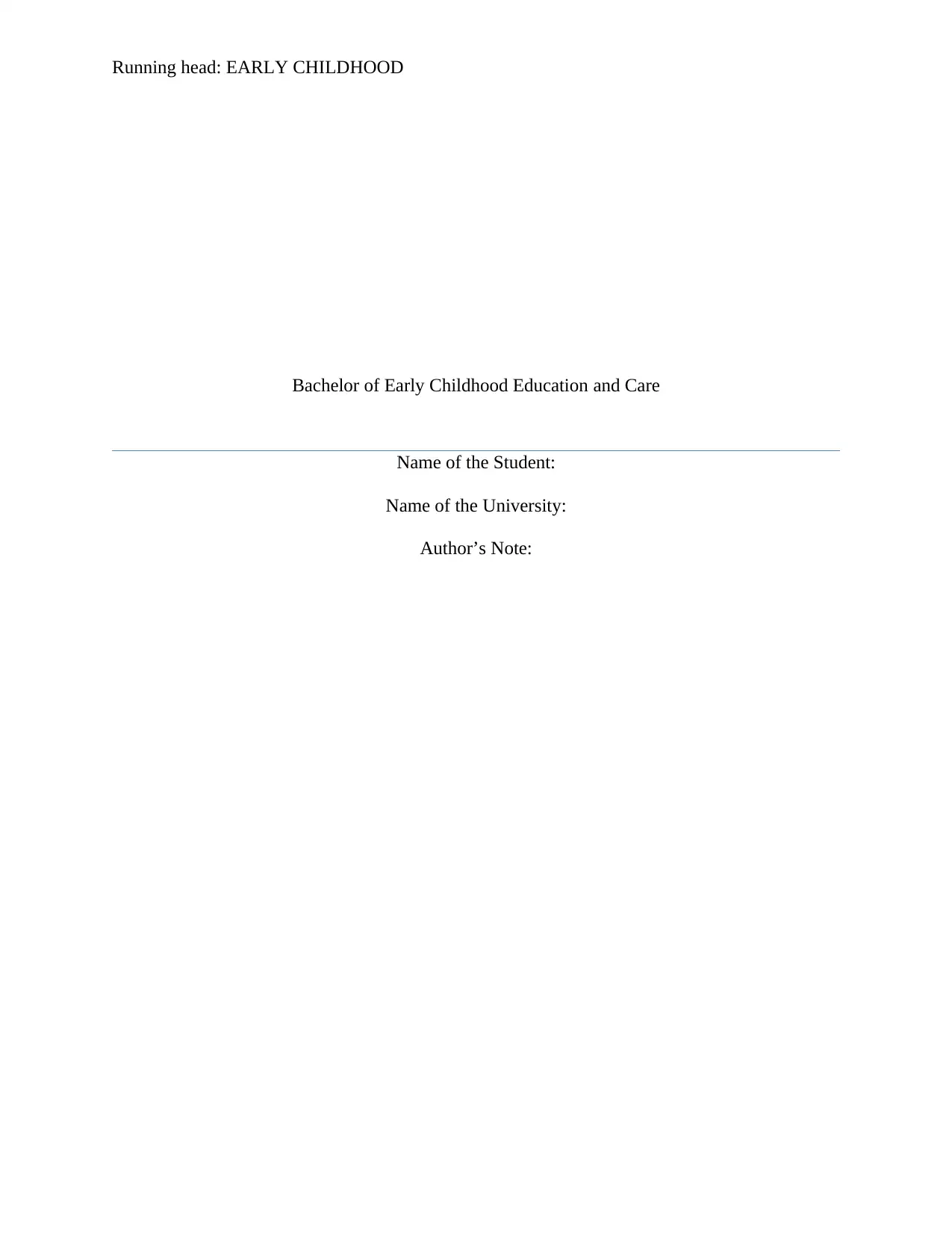
Running head: EARLY CHILDHOOD
Bachelor of Early Childhood Education and Care
Name of the Student:
Name of the University:
Author’s Note:
Bachelor of Early Childhood Education and Care
Name of the Student:
Name of the University:
Author’s Note:
Paraphrase This Document
Need a fresh take? Get an instant paraphrase of this document with our AI Paraphraser
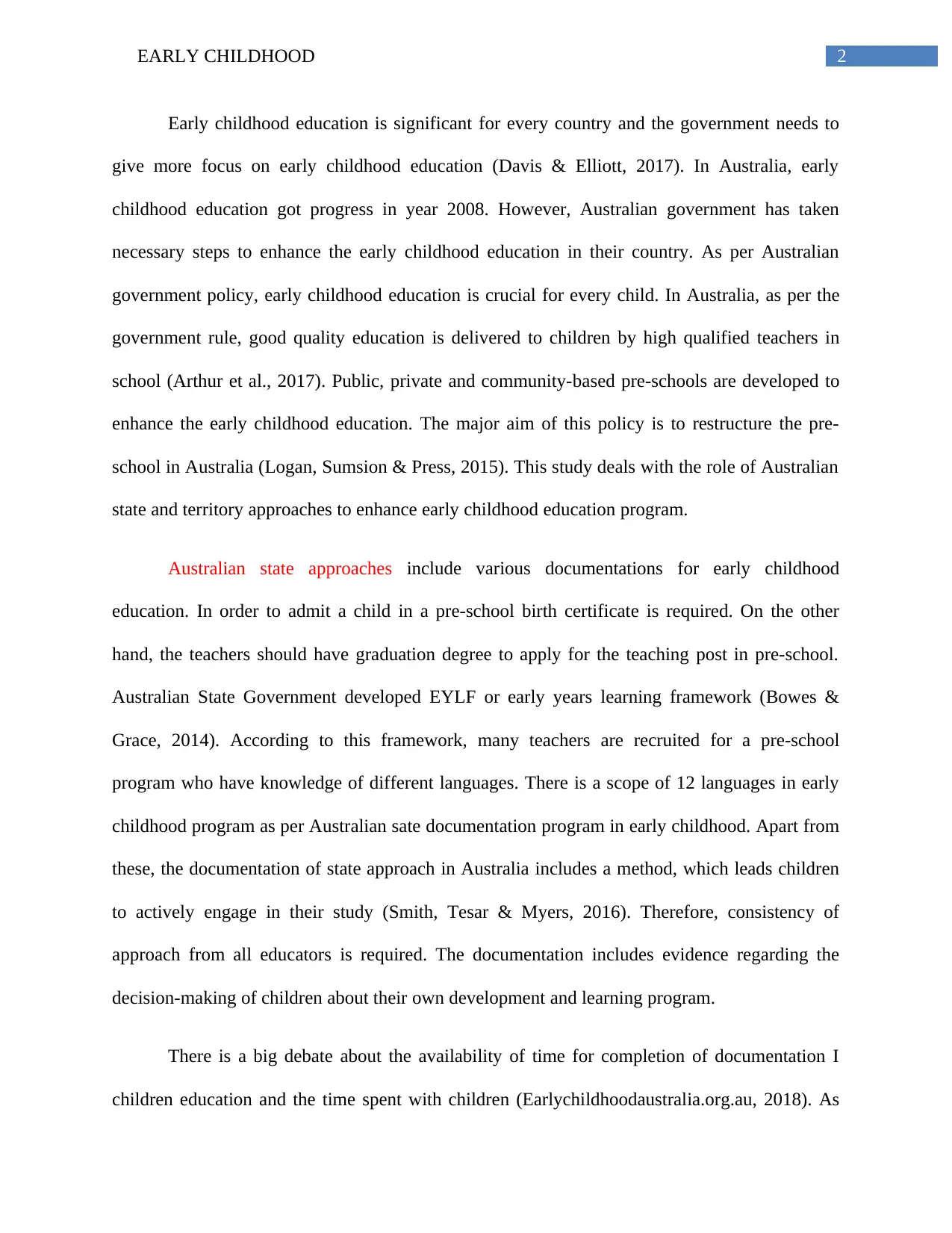
2EARLY CHILDHOOD
Early childhood education is significant for every country and the government needs to
give more focus on early childhood education (Davis & Elliott, 2017). In Australia, early
childhood education got progress in year 2008. However, Australian government has taken
necessary steps to enhance the early childhood education in their country. As per Australian
government policy, early childhood education is crucial for every child. In Australia, as per the
government rule, good quality education is delivered to children by high qualified teachers in
school (Arthur et al., 2017). Public, private and community-based pre-schools are developed to
enhance the early childhood education. The major aim of this policy is to restructure the pre-
school in Australia (Logan, Sumsion & Press, 2015). This study deals with the role of Australian
state and territory approaches to enhance early childhood education program.
Australian state approaches include various documentations for early childhood
education. In order to admit a child in a pre-school birth certificate is required. On the other
hand, the teachers should have graduation degree to apply for the teaching post in pre-school.
Australian State Government developed EYLF or early years learning framework (Bowes &
Grace, 2014). According to this framework, many teachers are recruited for a pre-school
program who have knowledge of different languages. There is a scope of 12 languages in early
childhood program as per Australian sate documentation program in early childhood. Apart from
these, the documentation of state approach in Australia includes a method, which leads children
to actively engage in their study (Smith, Tesar & Myers, 2016). Therefore, consistency of
approach from all educators is required. The documentation includes evidence regarding the
decision-making of children about their own development and learning program.
There is a big debate about the availability of time for completion of documentation I
children education and the time spent with children (Earlychildhoodaustralia.org.au, 2018). As
Early childhood education is significant for every country and the government needs to
give more focus on early childhood education (Davis & Elliott, 2017). In Australia, early
childhood education got progress in year 2008. However, Australian government has taken
necessary steps to enhance the early childhood education in their country. As per Australian
government policy, early childhood education is crucial for every child. In Australia, as per the
government rule, good quality education is delivered to children by high qualified teachers in
school (Arthur et al., 2017). Public, private and community-based pre-schools are developed to
enhance the early childhood education. The major aim of this policy is to restructure the pre-
school in Australia (Logan, Sumsion & Press, 2015). This study deals with the role of Australian
state and territory approaches to enhance early childhood education program.
Australian state approaches include various documentations for early childhood
education. In order to admit a child in a pre-school birth certificate is required. On the other
hand, the teachers should have graduation degree to apply for the teaching post in pre-school.
Australian State Government developed EYLF or early years learning framework (Bowes &
Grace, 2014). According to this framework, many teachers are recruited for a pre-school
program who have knowledge of different languages. There is a scope of 12 languages in early
childhood program as per Australian sate documentation program in early childhood. Apart from
these, the documentation of state approach in Australia includes a method, which leads children
to actively engage in their study (Smith, Tesar & Myers, 2016). Therefore, consistency of
approach from all educators is required. The documentation includes evidence regarding the
decision-making of children about their own development and learning program.
There is a big debate about the availability of time for completion of documentation I
children education and the time spent with children (Earlychildhoodaustralia.org.au, 2018). As
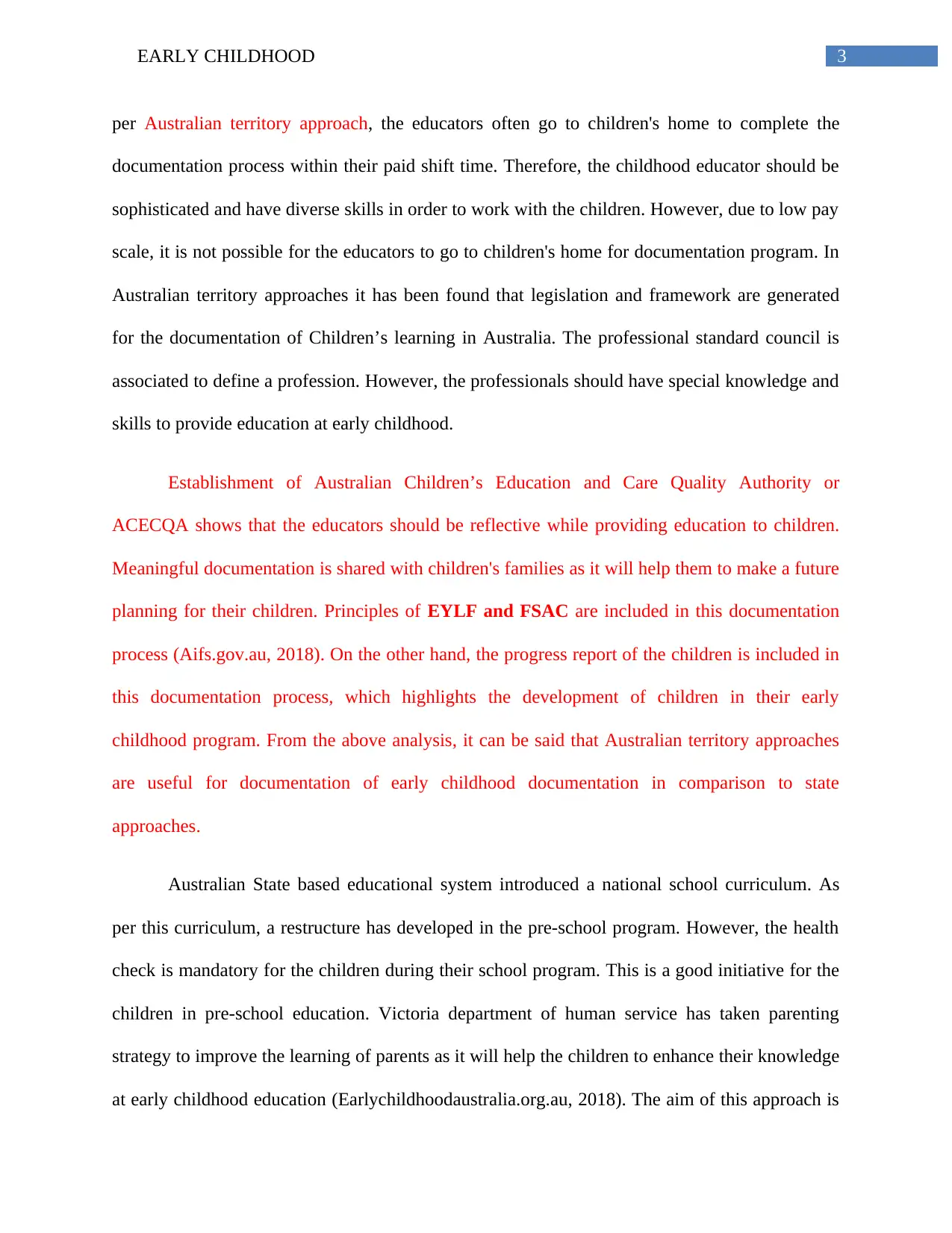
3EARLY CHILDHOOD
per Australian territory approach, the educators often go to children's home to complete the
documentation process within their paid shift time. Therefore, the childhood educator should be
sophisticated and have diverse skills in order to work with the children. However, due to low pay
scale, it is not possible for the educators to go to children's home for documentation program. In
Australian territory approaches it has been found that legislation and framework are generated
for the documentation of Children’s learning in Australia. The professional standard council is
associated to define a profession. However, the professionals should have special knowledge and
skills to provide education at early childhood.
Establishment of Australian Children’s Education and Care Quality Authority or
ACECQA shows that the educators should be reflective while providing education to children.
Meaningful documentation is shared with children's families as it will help them to make a future
planning for their children. Principles of EYLF and FSAC are included in this documentation
process (Aifs.gov.au, 2018). On the other hand, the progress report of the children is included in
this documentation process, which highlights the development of children in their early
childhood program. From the above analysis, it can be said that Australian territory approaches
are useful for documentation of early childhood documentation in comparison to state
approaches.
Australian State based educational system introduced a national school curriculum. As
per this curriculum, a restructure has developed in the pre-school program. However, the health
check is mandatory for the children during their school program. This is a good initiative for the
children in pre-school education. Victoria department of human service has taken parenting
strategy to improve the learning of parents as it will help the children to enhance their knowledge
at early childhood education (Earlychildhoodaustralia.org.au, 2018). The aim of this approach is
per Australian territory approach, the educators often go to children's home to complete the
documentation process within their paid shift time. Therefore, the childhood educator should be
sophisticated and have diverse skills in order to work with the children. However, due to low pay
scale, it is not possible for the educators to go to children's home for documentation program. In
Australian territory approaches it has been found that legislation and framework are generated
for the documentation of Children’s learning in Australia. The professional standard council is
associated to define a profession. However, the professionals should have special knowledge and
skills to provide education at early childhood.
Establishment of Australian Children’s Education and Care Quality Authority or
ACECQA shows that the educators should be reflective while providing education to children.
Meaningful documentation is shared with children's families as it will help them to make a future
planning for their children. Principles of EYLF and FSAC are included in this documentation
process (Aifs.gov.au, 2018). On the other hand, the progress report of the children is included in
this documentation process, which highlights the development of children in their early
childhood program. From the above analysis, it can be said that Australian territory approaches
are useful for documentation of early childhood documentation in comparison to state
approaches.
Australian State based educational system introduced a national school curriculum. As
per this curriculum, a restructure has developed in the pre-school program. However, the health
check is mandatory for the children during their school program. This is a good initiative for the
children in pre-school education. Victoria department of human service has taken parenting
strategy to improve the learning of parents as it will help the children to enhance their knowledge
at early childhood education (Earlychildhoodaustralia.org.au, 2018). The aim of this approach is
⊘ This is a preview!⊘
Do you want full access?
Subscribe today to unlock all pages.

Trusted by 1+ million students worldwide
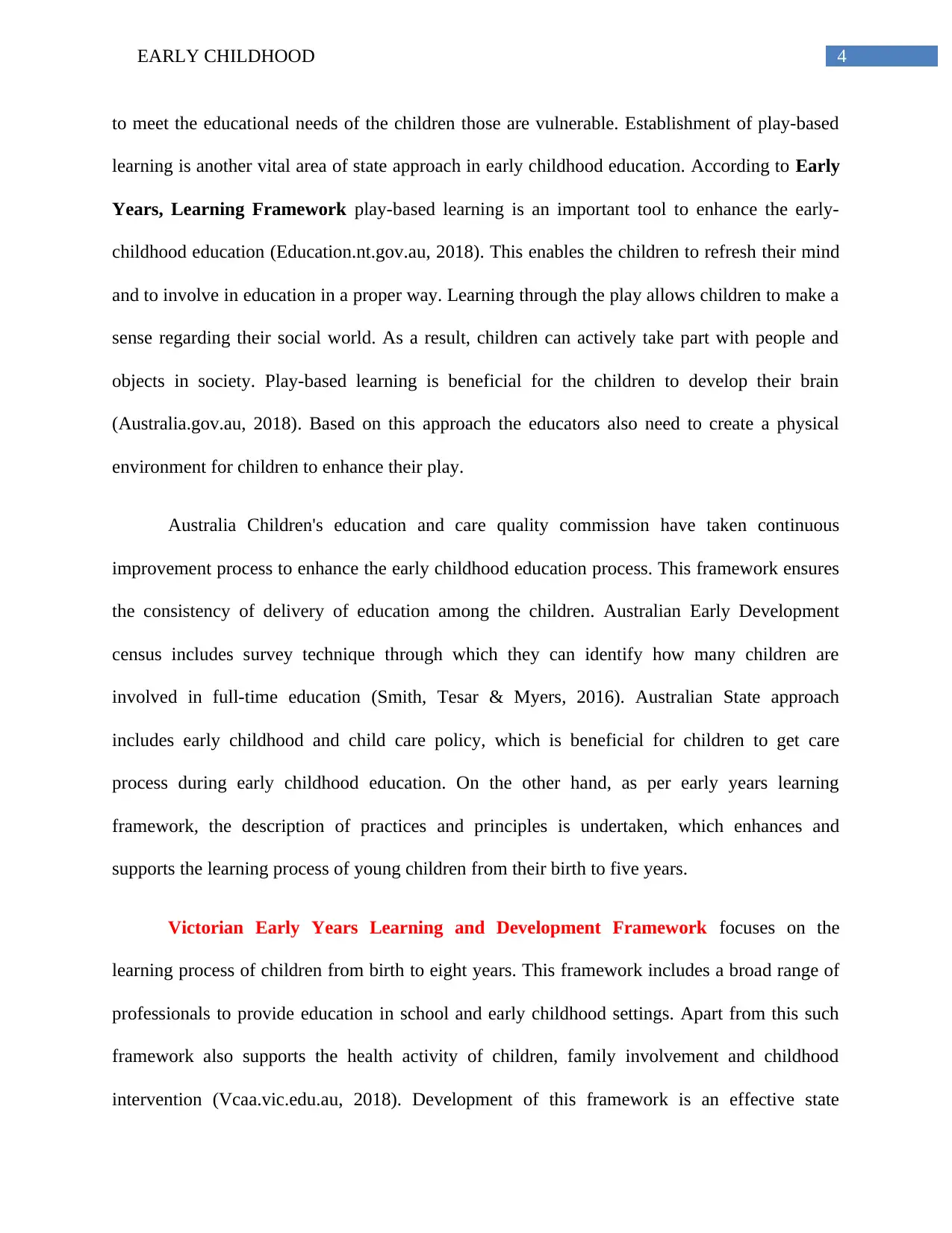
4EARLY CHILDHOOD
to meet the educational needs of the children those are vulnerable. Establishment of play-based
learning is another vital area of state approach in early childhood education. According to Early
Years, Learning Framework play-based learning is an important tool to enhance the early-
childhood education (Education.nt.gov.au, 2018). This enables the children to refresh their mind
and to involve in education in a proper way. Learning through the play allows children to make a
sense regarding their social world. As a result, children can actively take part with people and
objects in society. Play-based learning is beneficial for the children to develop their brain
(Australia.gov.au, 2018). Based on this approach the educators also need to create a physical
environment for children to enhance their play.
Australia Children's education and care quality commission have taken continuous
improvement process to enhance the early childhood education process. This framework ensures
the consistency of delivery of education among the children. Australian Early Development
census includes survey technique through which they can identify how many children are
involved in full-time education (Smith, Tesar & Myers, 2016). Australian State approach
includes early childhood and child care policy, which is beneficial for children to get care
process during early childhood education. On the other hand, as per early years learning
framework, the description of practices and principles is undertaken, which enhances and
supports the learning process of young children from their birth to five years.
Victorian Early Years Learning and Development Framework focuses on the
learning process of children from birth to eight years. This framework includes a broad range of
professionals to provide education in school and early childhood settings. Apart from this such
framework also supports the health activity of children, family involvement and childhood
intervention (Vcaa.vic.edu.au, 2018). Development of this framework is an effective state
to meet the educational needs of the children those are vulnerable. Establishment of play-based
learning is another vital area of state approach in early childhood education. According to Early
Years, Learning Framework play-based learning is an important tool to enhance the early-
childhood education (Education.nt.gov.au, 2018). This enables the children to refresh their mind
and to involve in education in a proper way. Learning through the play allows children to make a
sense regarding their social world. As a result, children can actively take part with people and
objects in society. Play-based learning is beneficial for the children to develop their brain
(Australia.gov.au, 2018). Based on this approach the educators also need to create a physical
environment for children to enhance their play.
Australia Children's education and care quality commission have taken continuous
improvement process to enhance the early childhood education process. This framework ensures
the consistency of delivery of education among the children. Australian Early Development
census includes survey technique through which they can identify how many children are
involved in full-time education (Smith, Tesar & Myers, 2016). Australian State approach
includes early childhood and child care policy, which is beneficial for children to get care
process during early childhood education. On the other hand, as per early years learning
framework, the description of practices and principles is undertaken, which enhances and
supports the learning process of young children from their birth to five years.
Victorian Early Years Learning and Development Framework focuses on the
learning process of children from birth to eight years. This framework includes a broad range of
professionals to provide education in school and early childhood settings. Apart from this such
framework also supports the health activity of children, family involvement and childhood
intervention (Vcaa.vic.edu.au, 2018). Development of this framework is an effective state
Paraphrase This Document
Need a fresh take? Get an instant paraphrase of this document with our AI Paraphraser
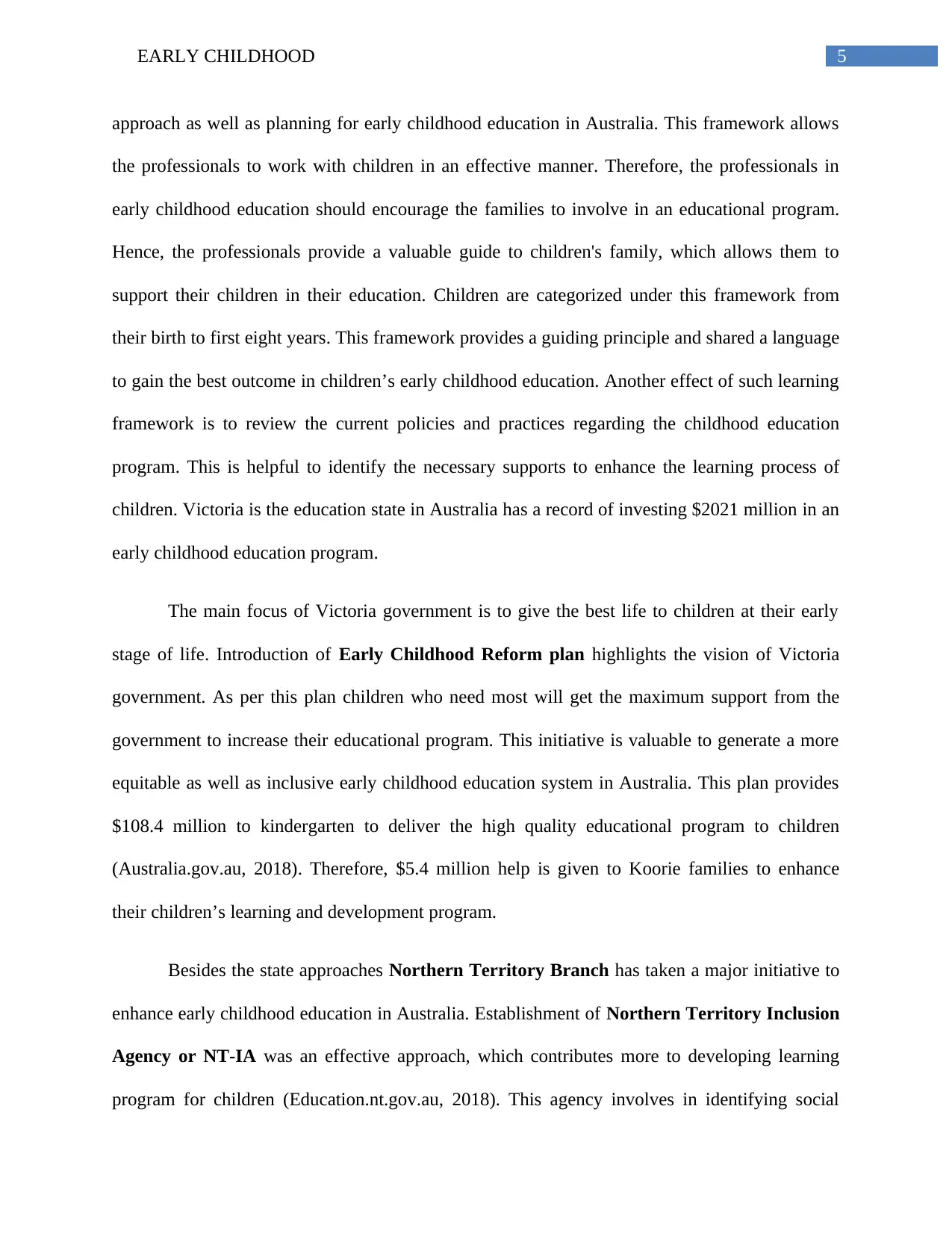
5EARLY CHILDHOOD
approach as well as planning for early childhood education in Australia. This framework allows
the professionals to work with children in an effective manner. Therefore, the professionals in
early childhood education should encourage the families to involve in an educational program.
Hence, the professionals provide a valuable guide to children's family, which allows them to
support their children in their education. Children are categorized under this framework from
their birth to first eight years. This framework provides a guiding principle and shared a language
to gain the best outcome in children’s early childhood education. Another effect of such learning
framework is to review the current policies and practices regarding the childhood education
program. This is helpful to identify the necessary supports to enhance the learning process of
children. Victoria is the education state in Australia has a record of investing $2021 million in an
early childhood education program.
The main focus of Victoria government is to give the best life to children at their early
stage of life. Introduction of Early Childhood Reform plan highlights the vision of Victoria
government. As per this plan children who need most will get the maximum support from the
government to increase their educational program. This initiative is valuable to generate a more
equitable as well as inclusive early childhood education system in Australia. This plan provides
$108.4 million to kindergarten to deliver the high quality educational program to children
(Australia.gov.au, 2018). Therefore, $5.4 million help is given to Koorie families to enhance
their children’s learning and development program.
Besides the state approaches Northern Territory Branch has taken a major initiative to
enhance early childhood education in Australia. Establishment of Northern Territory Inclusion
Agency or NT-IA was an effective approach, which contributes more to developing learning
program for children (Education.nt.gov.au, 2018). This agency involves in identifying social
approach as well as planning for early childhood education in Australia. This framework allows
the professionals to work with children in an effective manner. Therefore, the professionals in
early childhood education should encourage the families to involve in an educational program.
Hence, the professionals provide a valuable guide to children's family, which allows them to
support their children in their education. Children are categorized under this framework from
their birth to first eight years. This framework provides a guiding principle and shared a language
to gain the best outcome in children’s early childhood education. Another effect of such learning
framework is to review the current policies and practices regarding the childhood education
program. This is helpful to identify the necessary supports to enhance the learning process of
children. Victoria is the education state in Australia has a record of investing $2021 million in an
early childhood education program.
The main focus of Victoria government is to give the best life to children at their early
stage of life. Introduction of Early Childhood Reform plan highlights the vision of Victoria
government. As per this plan children who need most will get the maximum support from the
government to increase their educational program. This initiative is valuable to generate a more
equitable as well as inclusive early childhood education system in Australia. This plan provides
$108.4 million to kindergarten to deliver the high quality educational program to children
(Australia.gov.au, 2018). Therefore, $5.4 million help is given to Koorie families to enhance
their children’s learning and development program.
Besides the state approaches Northern Territory Branch has taken a major initiative to
enhance early childhood education in Australia. Establishment of Northern Territory Inclusion
Agency or NT-IA was an effective approach, which contributes more to developing learning
program for children (Education.nt.gov.au, 2018). This agency involves in identifying social
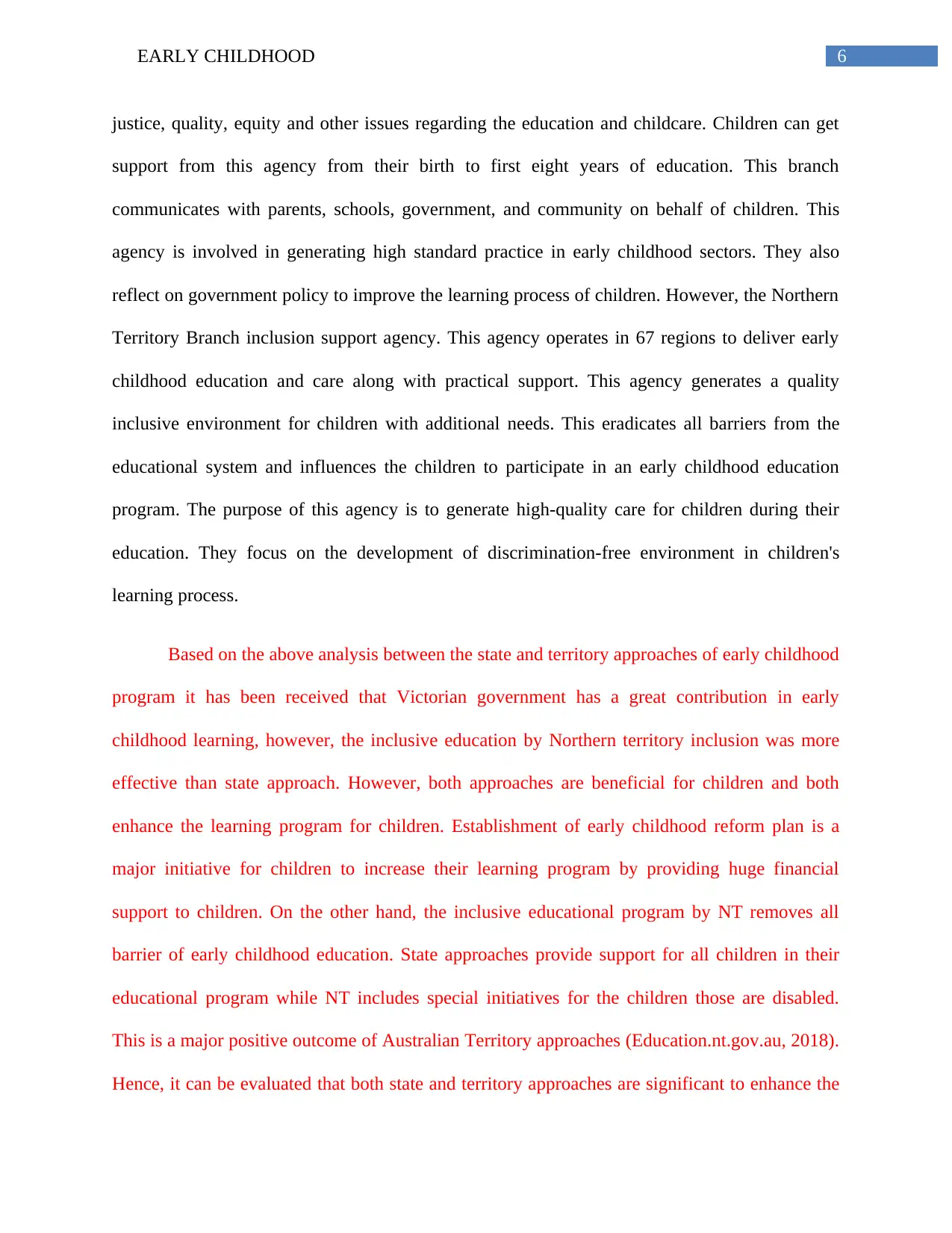
6EARLY CHILDHOOD
justice, quality, equity and other issues regarding the education and childcare. Children can get
support from this agency from their birth to first eight years of education. This branch
communicates with parents, schools, government, and community on behalf of children. This
agency is involved in generating high standard practice in early childhood sectors. They also
reflect on government policy to improve the learning process of children. However, the Northern
Territory Branch inclusion support agency. This agency operates in 67 regions to deliver early
childhood education and care along with practical support. This agency generates a quality
inclusive environment for children with additional needs. This eradicates all barriers from the
educational system and influences the children to participate in an early childhood education
program. The purpose of this agency is to generate high-quality care for children during their
education. They focus on the development of discrimination-free environment in children's
learning process.
Based on the above analysis between the state and territory approaches of early childhood
program it has been received that Victorian government has a great contribution in early
childhood learning, however, the inclusive education by Northern territory inclusion was more
effective than state approach. However, both approaches are beneficial for children and both
enhance the learning program for children. Establishment of early childhood reform plan is a
major initiative for children to increase their learning program by providing huge financial
support to children. On the other hand, the inclusive educational program by NT removes all
barrier of early childhood education. State approaches provide support for all children in their
educational program while NT includes special initiatives for the children those are disabled.
This is a major positive outcome of Australian Territory approaches (Education.nt.gov.au, 2018).
Hence, it can be evaluated that both state and territory approaches are significant to enhance the
justice, quality, equity and other issues regarding the education and childcare. Children can get
support from this agency from their birth to first eight years of education. This branch
communicates with parents, schools, government, and community on behalf of children. This
agency is involved in generating high standard practice in early childhood sectors. They also
reflect on government policy to improve the learning process of children. However, the Northern
Territory Branch inclusion support agency. This agency operates in 67 regions to deliver early
childhood education and care along with practical support. This agency generates a quality
inclusive environment for children with additional needs. This eradicates all barriers from the
educational system and influences the children to participate in an early childhood education
program. The purpose of this agency is to generate high-quality care for children during their
education. They focus on the development of discrimination-free environment in children's
learning process.
Based on the above analysis between the state and territory approaches of early childhood
program it has been received that Victorian government has a great contribution in early
childhood learning, however, the inclusive education by Northern territory inclusion was more
effective than state approach. However, both approaches are beneficial for children and both
enhance the learning program for children. Establishment of early childhood reform plan is a
major initiative for children to increase their learning program by providing huge financial
support to children. On the other hand, the inclusive educational program by NT removes all
barrier of early childhood education. State approaches provide support for all children in their
educational program while NT includes special initiatives for the children those are disabled.
This is a major positive outcome of Australian Territory approaches (Education.nt.gov.au, 2018).
Hence, it can be evaluated that both state and territory approaches are significant to enhance the
⊘ This is a preview!⊘
Do you want full access?
Subscribe today to unlock all pages.

Trusted by 1+ million students worldwide
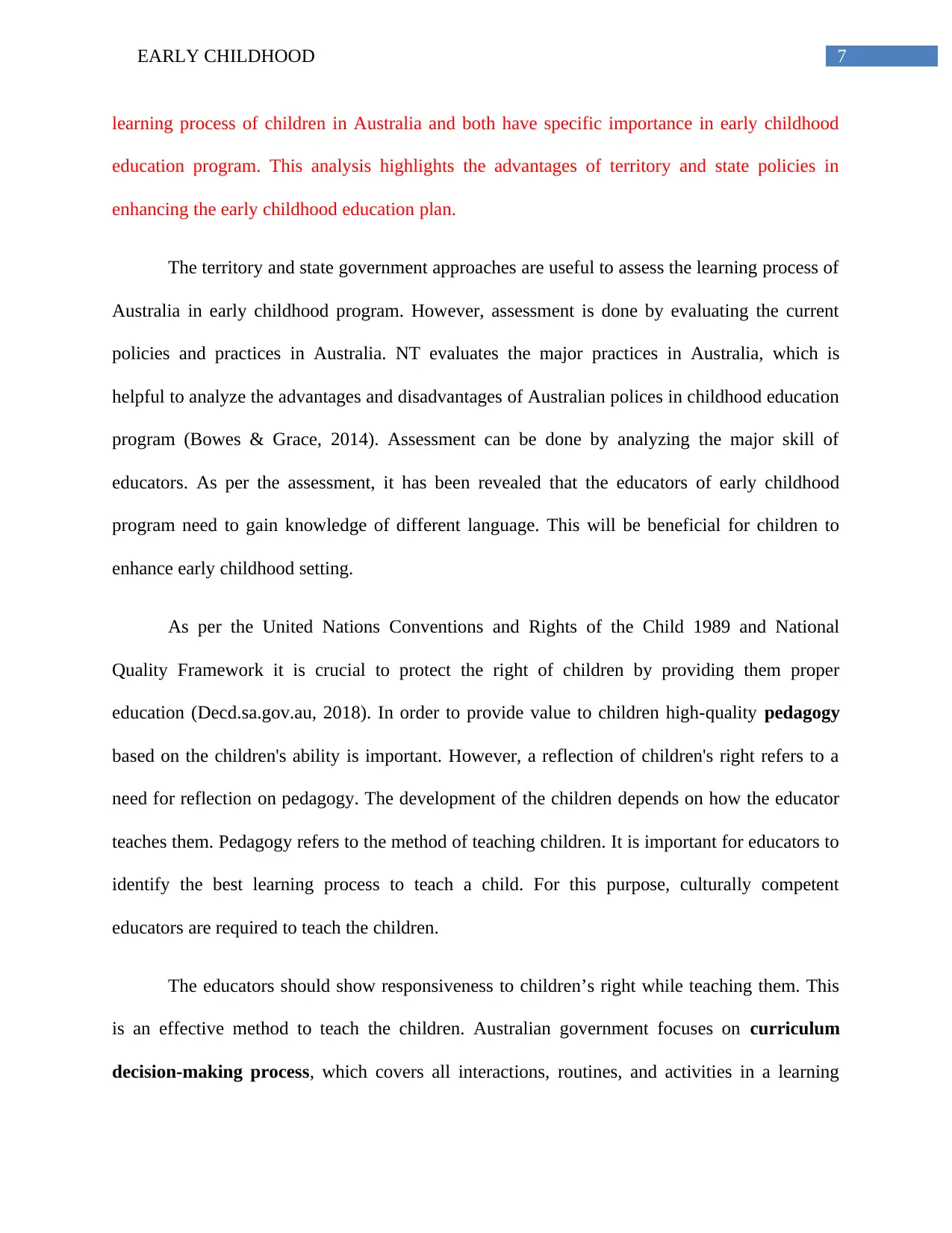
7EARLY CHILDHOOD
learning process of children in Australia and both have specific importance in early childhood
education program. This analysis highlights the advantages of territory and state policies in
enhancing the early childhood education plan.
The territory and state government approaches are useful to assess the learning process of
Australia in early childhood program. However, assessment is done by evaluating the current
policies and practices in Australia. NT evaluates the major practices in Australia, which is
helpful to analyze the advantages and disadvantages of Australian polices in childhood education
program (Bowes & Grace, 2014). Assessment can be done by analyzing the major skill of
educators. As per the assessment, it has been revealed that the educators of early childhood
program need to gain knowledge of different language. This will be beneficial for children to
enhance early childhood setting.
As per the United Nations Conventions and Rights of the Child 1989 and National
Quality Framework it is crucial to protect the right of children by providing them proper
education (Decd.sa.gov.au, 2018). In order to provide value to children high-quality pedagogy
based on the children's ability is important. However, a reflection of children's right refers to a
need for reflection on pedagogy. The development of the children depends on how the educator
teaches them. Pedagogy refers to the method of teaching children. It is important for educators to
identify the best learning process to teach a child. For this purpose, culturally competent
educators are required to teach the children.
The educators should show responsiveness to children’s right while teaching them. This
is an effective method to teach the children. Australian government focuses on curriculum
decision-making process, which covers all interactions, routines, and activities in a learning
learning process of children in Australia and both have specific importance in early childhood
education program. This analysis highlights the advantages of territory and state policies in
enhancing the early childhood education plan.
The territory and state government approaches are useful to assess the learning process of
Australia in early childhood program. However, assessment is done by evaluating the current
policies and practices in Australia. NT evaluates the major practices in Australia, which is
helpful to analyze the advantages and disadvantages of Australian polices in childhood education
program (Bowes & Grace, 2014). Assessment can be done by analyzing the major skill of
educators. As per the assessment, it has been revealed that the educators of early childhood
program need to gain knowledge of different language. This will be beneficial for children to
enhance early childhood setting.
As per the United Nations Conventions and Rights of the Child 1989 and National
Quality Framework it is crucial to protect the right of children by providing them proper
education (Decd.sa.gov.au, 2018). In order to provide value to children high-quality pedagogy
based on the children's ability is important. However, a reflection of children's right refers to a
need for reflection on pedagogy. The development of the children depends on how the educator
teaches them. Pedagogy refers to the method of teaching children. It is important for educators to
identify the best learning process to teach a child. For this purpose, culturally competent
educators are required to teach the children.
The educators should show responsiveness to children’s right while teaching them. This
is an effective method to teach the children. Australian government focuses on curriculum
decision-making process, which covers all interactions, routines, and activities in a learning
Paraphrase This Document
Need a fresh take? Get an instant paraphrase of this document with our AI Paraphraser
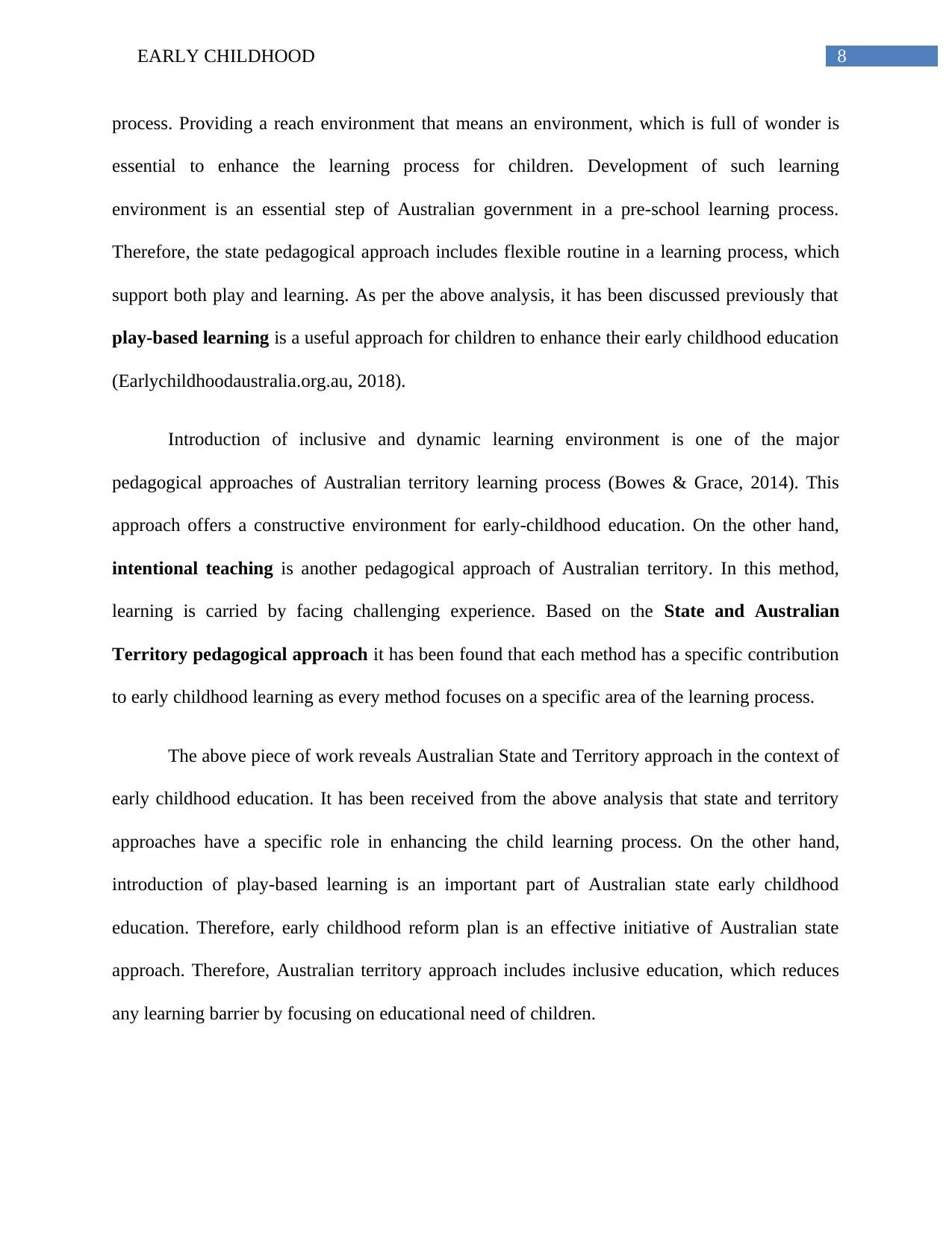
8EARLY CHILDHOOD
process. Providing a reach environment that means an environment, which is full of wonder is
essential to enhance the learning process for children. Development of such learning
environment is an essential step of Australian government in a pre-school learning process.
Therefore, the state pedagogical approach includes flexible routine in a learning process, which
support both play and learning. As per the above analysis, it has been discussed previously that
play-based learning is a useful approach for children to enhance their early childhood education
(Earlychildhoodaustralia.org.au, 2018).
Introduction of inclusive and dynamic learning environment is one of the major
pedagogical approaches of Australian territory learning process (Bowes & Grace, 2014). This
approach offers a constructive environment for early-childhood education. On the other hand,
intentional teaching is another pedagogical approach of Australian territory. In this method,
learning is carried by facing challenging experience. Based on the State and Australian
Territory pedagogical approach it has been found that each method has a specific contribution
to early childhood learning as every method focuses on a specific area of the learning process.
The above piece of work reveals Australian State and Territory approach in the context of
early childhood education. It has been received from the above analysis that state and territory
approaches have a specific role in enhancing the child learning process. On the other hand,
introduction of play-based learning is an important part of Australian state early childhood
education. Therefore, early childhood reform plan is an effective initiative of Australian state
approach. Therefore, Australian territory approach includes inclusive education, which reduces
any learning barrier by focusing on educational need of children.
process. Providing a reach environment that means an environment, which is full of wonder is
essential to enhance the learning process for children. Development of such learning
environment is an essential step of Australian government in a pre-school learning process.
Therefore, the state pedagogical approach includes flexible routine in a learning process, which
support both play and learning. As per the above analysis, it has been discussed previously that
play-based learning is a useful approach for children to enhance their early childhood education
(Earlychildhoodaustralia.org.au, 2018).
Introduction of inclusive and dynamic learning environment is one of the major
pedagogical approaches of Australian territory learning process (Bowes & Grace, 2014). This
approach offers a constructive environment for early-childhood education. On the other hand,
intentional teaching is another pedagogical approach of Australian territory. In this method,
learning is carried by facing challenging experience. Based on the State and Australian
Territory pedagogical approach it has been found that each method has a specific contribution
to early childhood learning as every method focuses on a specific area of the learning process.
The above piece of work reveals Australian State and Territory approach in the context of
early childhood education. It has been received from the above analysis that state and territory
approaches have a specific role in enhancing the child learning process. On the other hand,
introduction of play-based learning is an important part of Australian state early childhood
education. Therefore, early childhood reform plan is an effective initiative of Australian state
approach. Therefore, Australian territory approach includes inclusive education, which reduces
any learning barrier by focusing on educational need of children.
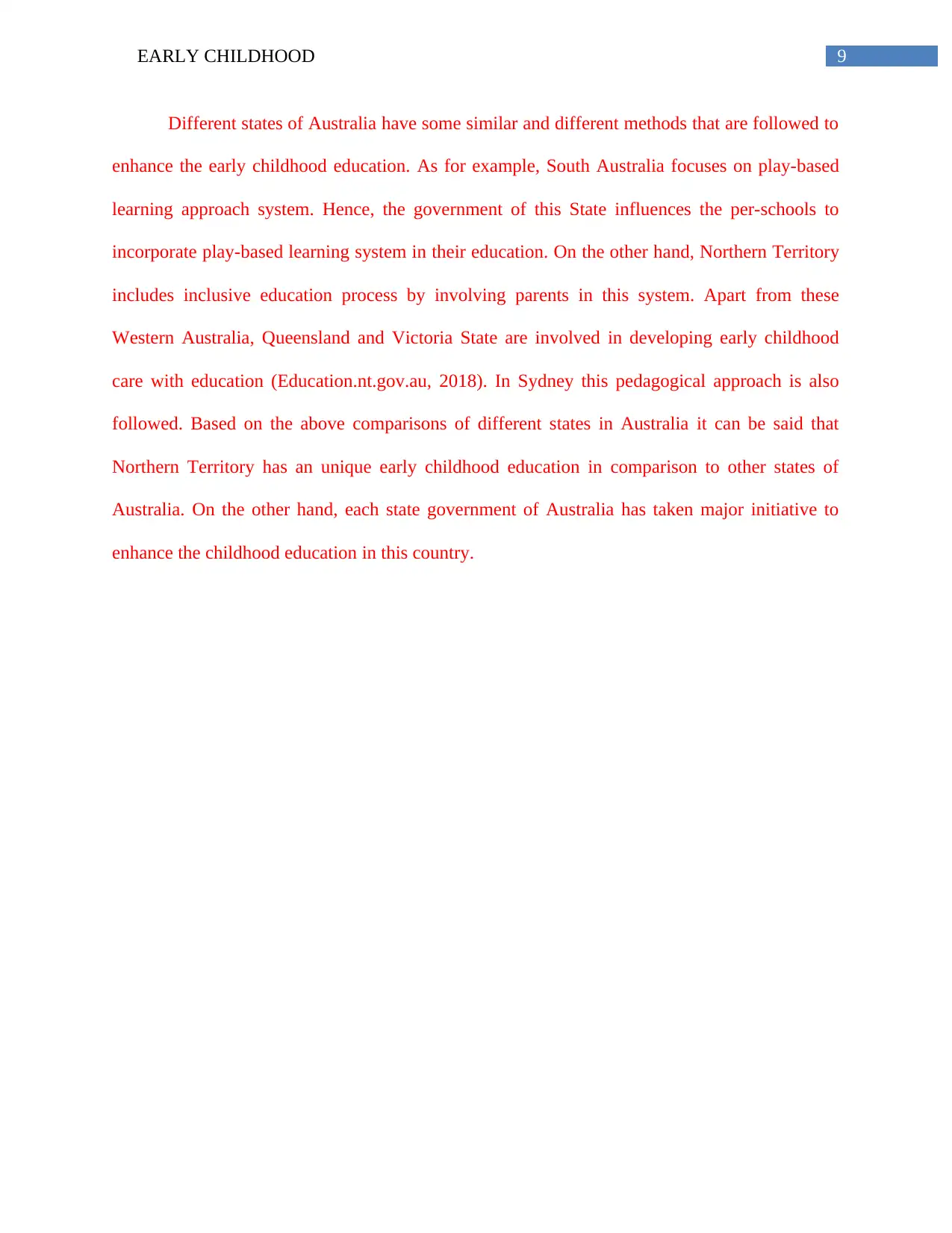
9EARLY CHILDHOOD
Different states of Australia have some similar and different methods that are followed to
enhance the early childhood education. As for example, South Australia focuses on play-based
learning approach system. Hence, the government of this State influences the per-schools to
incorporate play-based learning system in their education. On the other hand, Northern Territory
includes inclusive education process by involving parents in this system. Apart from these
Western Australia, Queensland and Victoria State are involved in developing early childhood
care with education (Education.nt.gov.au, 2018). In Sydney this pedagogical approach is also
followed. Based on the above comparisons of different states in Australia it can be said that
Northern Territory has an unique early childhood education in comparison to other states of
Australia. On the other hand, each state government of Australia has taken major initiative to
enhance the childhood education in this country.
Different states of Australia have some similar and different methods that are followed to
enhance the early childhood education. As for example, South Australia focuses on play-based
learning approach system. Hence, the government of this State influences the per-schools to
incorporate play-based learning system in their education. On the other hand, Northern Territory
includes inclusive education process by involving parents in this system. Apart from these
Western Australia, Queensland and Victoria State are involved in developing early childhood
care with education (Education.nt.gov.au, 2018). In Sydney this pedagogical approach is also
followed. Based on the above comparisons of different states in Australia it can be said that
Northern Territory has an unique early childhood education in comparison to other states of
Australia. On the other hand, each state government of Australia has taken major initiative to
enhance the childhood education in this country.
⊘ This is a preview!⊘
Do you want full access?
Subscribe today to unlock all pages.

Trusted by 1+ million students worldwide
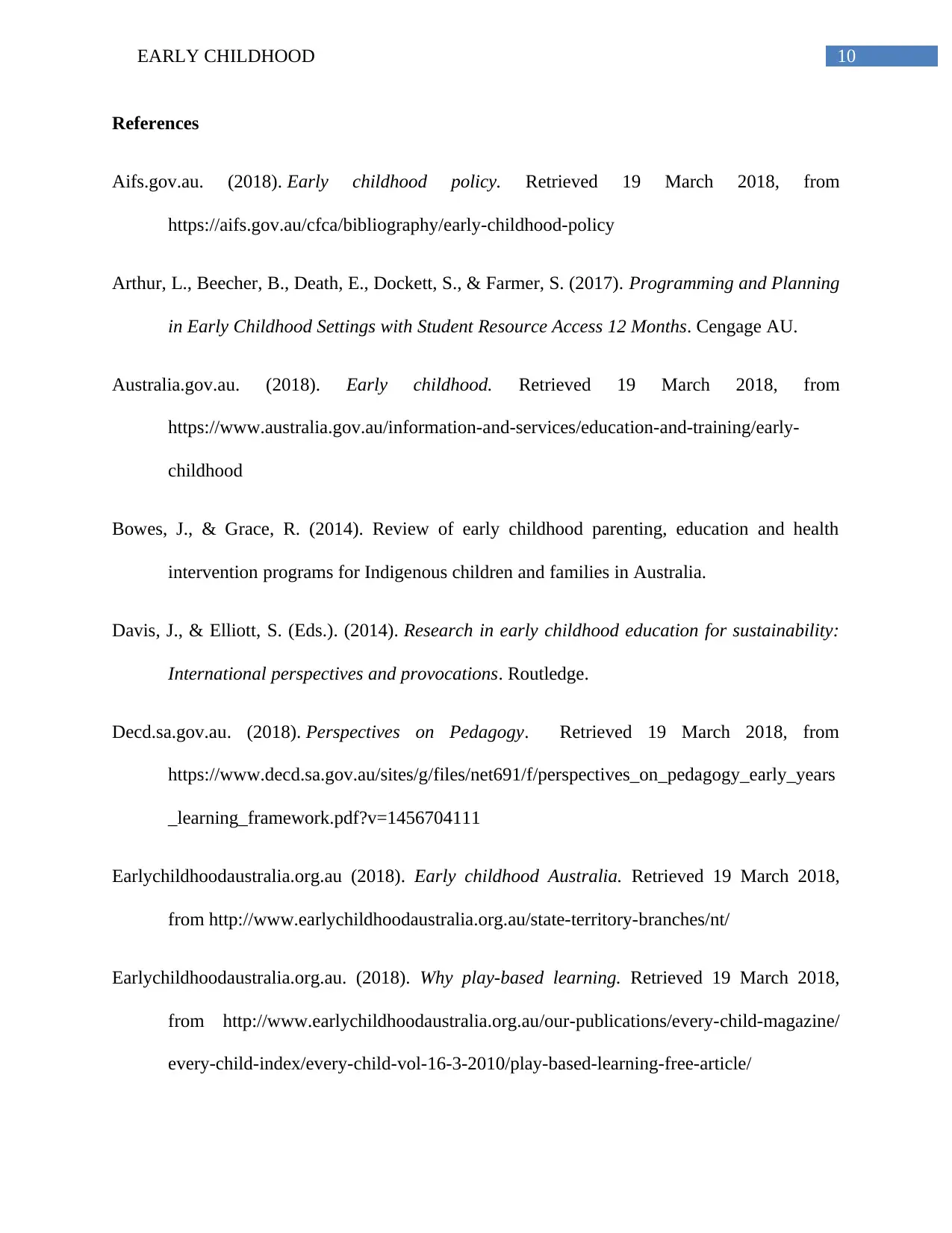
10EARLY CHILDHOOD
References
Aifs.gov.au. (2018). Early childhood policy. Retrieved 19 March 2018, from
https://aifs.gov.au/cfca/bibliography/early-childhood-policy
Arthur, L., Beecher, B., Death, E., Dockett, S., & Farmer, S. (2017). Programming and Planning
in Early Childhood Settings with Student Resource Access 12 Months. Cengage AU.
Australia.gov.au. (2018). Early childhood. Retrieved 19 March 2018, from
https://www.australia.gov.au/information-and-services/education-and-training/early-
childhood
Bowes, J., & Grace, R. (2014). Review of early childhood parenting, education and health
intervention programs for Indigenous children and families in Australia.
Davis, J., & Elliott, S. (Eds.). (2014). Research in early childhood education for sustainability:
International perspectives and provocations. Routledge.
Decd.sa.gov.au. (2018). Perspectives on Pedagogy. Retrieved 19 March 2018, from
https://www.decd.sa.gov.au/sites/g/files/net691/f/perspectives_on_pedagogy_early_years
_learning_framework.pdf?v=1456704111
Earlychildhoodaustralia.org.au (2018). Early childhood Australia. Retrieved 19 March 2018,
from http://www.earlychildhoodaustralia.org.au/state-territory-branches/nt/
Earlychildhoodaustralia.org.au. (2018). Why play-based learning. Retrieved 19 March 2018,
from http://www.earlychildhoodaustralia.org.au/our-publications/every-child-magazine/
every-child-index/every-child-vol-16-3-2010/play-based-learning-free-article/
References
Aifs.gov.au. (2018). Early childhood policy. Retrieved 19 March 2018, from
https://aifs.gov.au/cfca/bibliography/early-childhood-policy
Arthur, L., Beecher, B., Death, E., Dockett, S., & Farmer, S. (2017). Programming and Planning
in Early Childhood Settings with Student Resource Access 12 Months. Cengage AU.
Australia.gov.au. (2018). Early childhood. Retrieved 19 March 2018, from
https://www.australia.gov.au/information-and-services/education-and-training/early-
childhood
Bowes, J., & Grace, R. (2014). Review of early childhood parenting, education and health
intervention programs for Indigenous children and families in Australia.
Davis, J., & Elliott, S. (Eds.). (2014). Research in early childhood education for sustainability:
International perspectives and provocations. Routledge.
Decd.sa.gov.au. (2018). Perspectives on Pedagogy. Retrieved 19 March 2018, from
https://www.decd.sa.gov.au/sites/g/files/net691/f/perspectives_on_pedagogy_early_years
_learning_framework.pdf?v=1456704111
Earlychildhoodaustralia.org.au (2018). Early childhood Australia. Retrieved 19 March 2018,
from http://www.earlychildhoodaustralia.org.au/state-territory-branches/nt/
Earlychildhoodaustralia.org.au. (2018). Why play-based learning. Retrieved 19 March 2018,
from http://www.earlychildhoodaustralia.org.au/our-publications/every-child-magazine/
every-child-index/every-child-vol-16-3-2010/play-based-learning-free-article/
Paraphrase This Document
Need a fresh take? Get an instant paraphrase of this document with our AI Paraphraser
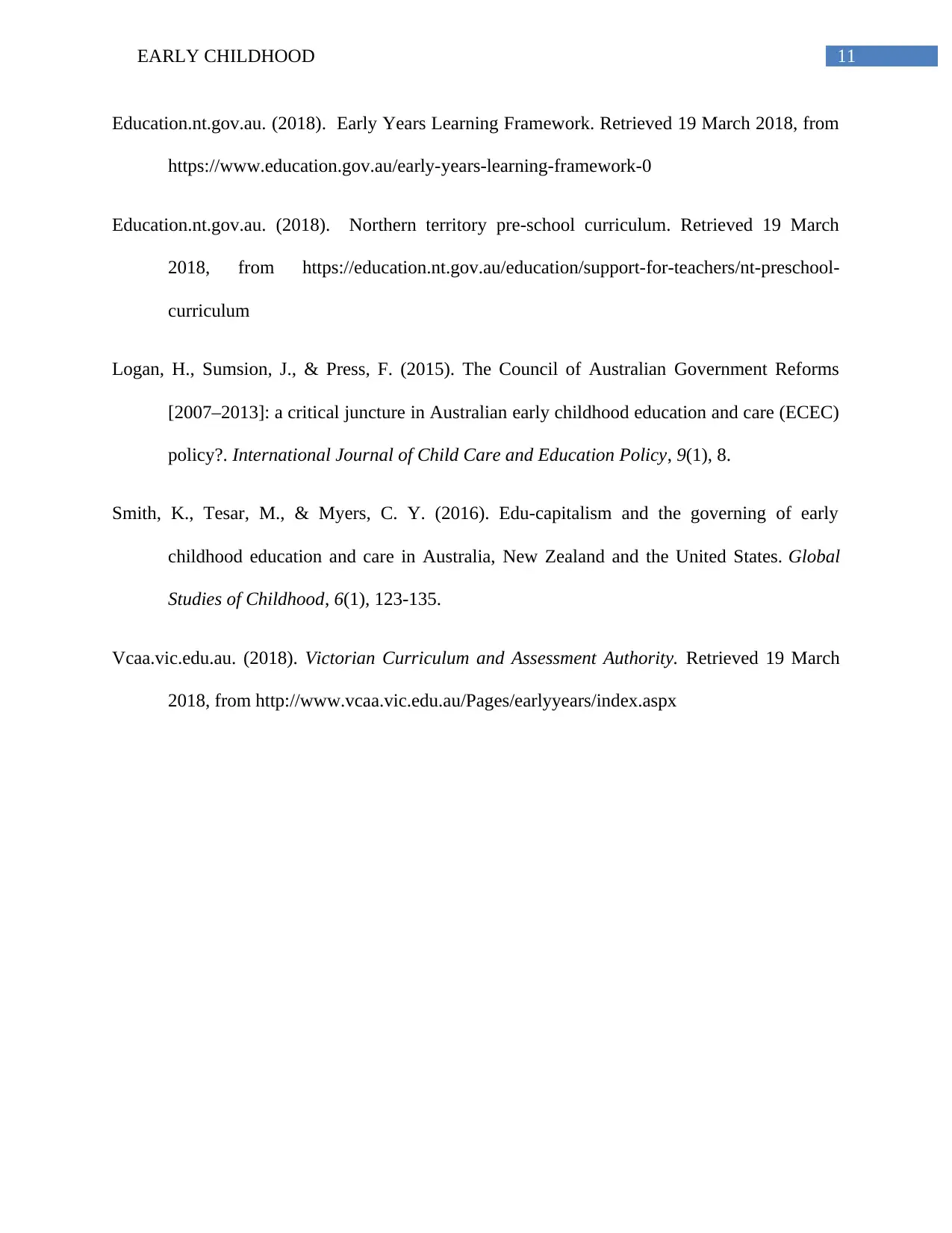
11EARLY CHILDHOOD
Education.nt.gov.au. (2018). Early Years Learning Framework. Retrieved 19 March 2018, from
https://www.education.gov.au/early-years-learning-framework-0
Education.nt.gov.au. (2018). Northern territory pre-school curriculum. Retrieved 19 March
2018, from https://education.nt.gov.au/education/support-for-teachers/nt-preschool-
curriculum
Logan, H., Sumsion, J., & Press, F. (2015). The Council of Australian Government Reforms
[2007–2013]: a critical juncture in Australian early childhood education and care (ECEC)
policy?. International Journal of Child Care and Education Policy, 9(1), 8.
Smith, K., Tesar, M., & Myers, C. Y. (2016). Edu-capitalism and the governing of early
childhood education and care in Australia, New Zealand and the United States. Global
Studies of Childhood, 6(1), 123-135.
Vcaa.vic.edu.au. (2018). Victorian Curriculum and Assessment Authority. Retrieved 19 March
2018, from http://www.vcaa.vic.edu.au/Pages/earlyyears/index.aspx
Education.nt.gov.au. (2018). Early Years Learning Framework. Retrieved 19 March 2018, from
https://www.education.gov.au/early-years-learning-framework-0
Education.nt.gov.au. (2018). Northern territory pre-school curriculum. Retrieved 19 March
2018, from https://education.nt.gov.au/education/support-for-teachers/nt-preschool-
curriculum
Logan, H., Sumsion, J., & Press, F. (2015). The Council of Australian Government Reforms
[2007–2013]: a critical juncture in Australian early childhood education and care (ECEC)
policy?. International Journal of Child Care and Education Policy, 9(1), 8.
Smith, K., Tesar, M., & Myers, C. Y. (2016). Edu-capitalism and the governing of early
childhood education and care in Australia, New Zealand and the United States. Global
Studies of Childhood, 6(1), 123-135.
Vcaa.vic.edu.au. (2018). Victorian Curriculum and Assessment Authority. Retrieved 19 March
2018, from http://www.vcaa.vic.edu.au/Pages/earlyyears/index.aspx
1 out of 11
Related Documents
Your All-in-One AI-Powered Toolkit for Academic Success.
+13062052269
info@desklib.com
Available 24*7 on WhatsApp / Email
![[object Object]](/_next/static/media/star-bottom.7253800d.svg)
Unlock your academic potential
Copyright © 2020–2025 A2Z Services. All Rights Reserved. Developed and managed by ZUCOL.





